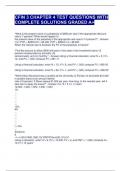CFIN 3 CHAPTER 4 TEST QUESTIONS WITH
COMPLETE SOLUTIONS GRADED A+
"What is the present value of a perpetuity of $280 per year if the appropriate discount
rate is 7 percent? What would happen to
the present value of the perpetuity if the appropriate rate rose to 14 percent?" - Answer-
\n\n "PVP = $280/0.07 = $4,000. PVP = $280/0.14 = $2,000.
When the interest rate is doubled, the PV of the perpetuity is halved."
"Find the amount to which $500 will grow in five years if the investment earns 12
percent compounded (a) annually, (b)
semiannually, and (c) monthly." - Answer-Using a financial calculator, enter N = 5, I/Y=
12, and PV = -500; compute FV = 881.17
Using a financial calculator, enter N = 10, I/Y= 6, and PV = -500; compute FV = 895.42
Using a financial calculator, enter N = 60, I/Y= 1, and PV = -500; compute FV = 908.35"
"While Steve Bouchard was a student at the University of Florida, he borrowed $12,000
in student loans at an annual interest
rate of 9 percent. If Steve repays $1,500 per year, how long, to the nearest year, will it
take him to repay the loans?" - Answer-\n\n "0 1 2 n-1 n Years
12,000 -1,500 -1,500 -1,500 -1,500
1%
...
...
...
...
...
12%
6%
...
...
...
...
...
r = 9%
...
Solutions
6
−=−=+09.01500,1000,12r1PMTPVAnn)09.1(1)r1(1
Using a calculator, enter I/Y= 9, PV = 12,000, FV = 0, and PMT = -1,500; compute N =
14.77 ≈ 15 years"
, "Hilda invested $5,000 four years ago. If the investment is now worth $7,058, what rate
of return has Hilda earned on her
investment? Assume that interest is compounded annually." - Answer-Using a
calculator, enter N = 4, PV = -5,000, PMT = 0, and FV = 7,058; compute I/Y= 9%."
"Jack just discovered that he holds the winning ticket for the $87 million "mega" lottery
in Missouri. Now he must decide which
alternative to choose: (a) a $44 million lump-sum payment today or (b) a payment of
$2.9 million per year for 30 years. With the
second option, the first payment will be made today. If Jack's opportunity cost is 5
percent, which alternative should he choose?" - Answer-alculator: Switch to begin
mode, n = 30, I/Y= 5, PMT = 2,900,000, and FV = 0; compute PV = -46,809,113.
Because PVA(DUE) = $46,809,113, which is greater than the lump-sum payment of $44
million, the annuity option should be chosen."
"Your broker offers to sell you a note for $13,250 that will pay $2,345.05 per year for 10
years. If you buy the note, what rate of
interest (to the closest percent) will you be earning?" - Answer-Using a calculator, enter
N = 10, PV = -13,250, PMT = 2,345.05, and FV = 0; compute I/Y= 12%."
"Brandi just received her credit card bill, which has an outstanding balance equal to
$3,310. The credit card carries an 18 percent
simple interest rate, which is compounded monthly. If Brandi pays $150 each month,
how long will it take her to pay off the credit
card bill? Assume that the only charge Brandi incurs from month to month is the interest
that must be paid on the remaining
outstanding balance." - Answer-Calculator solution: I/Y= 18/12 = 1.5, PV = 3,310, PMT
= -150, and FV = 0; N = ? = 27.0 months, or 2.2 years."
"Allison wants to pay off her existing automobile loan. Two years ago, Allison borrowed
$35,600 with terms that required her to
make monthly payments equal to $739 for a period of five years. The interest rate on
the loan is 9 percent. To the nearest dollar, how
much does Allison currently owe on her automobile loan? The most recent payment on
the loan was made yesterday." - Answer-Calculator solution: N = 36, I/Y= 9/12 = 0.75,
PMT = -739, and FV = 0; PV = ? = 23,239."
"If the appropriate interest rate is 8 percent, what are the present values of the following
cash flow streams?
Year Cash Stream A Cash Stream B
1 $100 $300
2 400 400
3 400 400
4 300 100" - Answer-Using a financial calculator, simply enter the cash flows into the
cash flow register (be sure to enter CF0 = 0), enter I/Y= 8, and press the NPV key to




